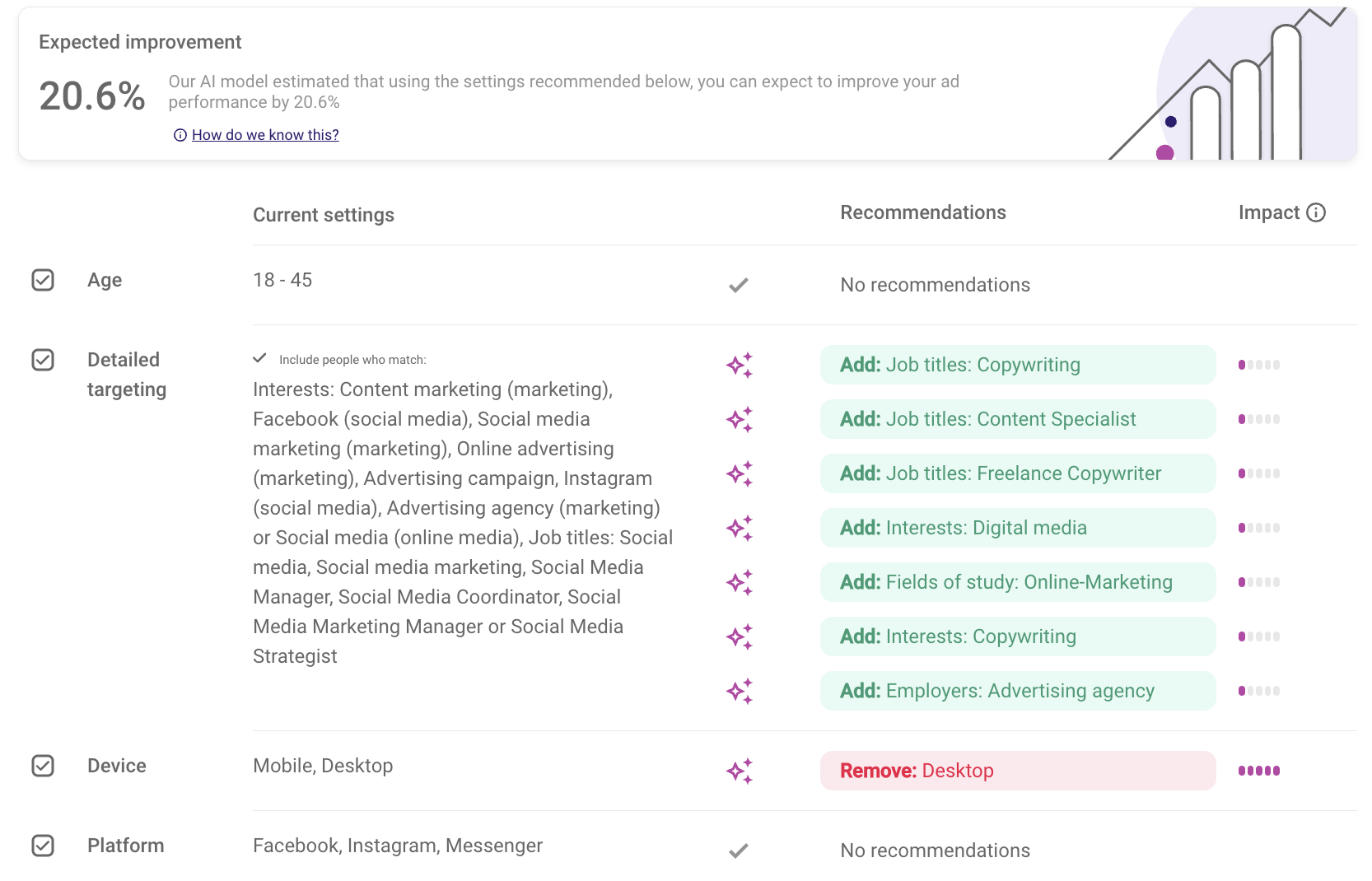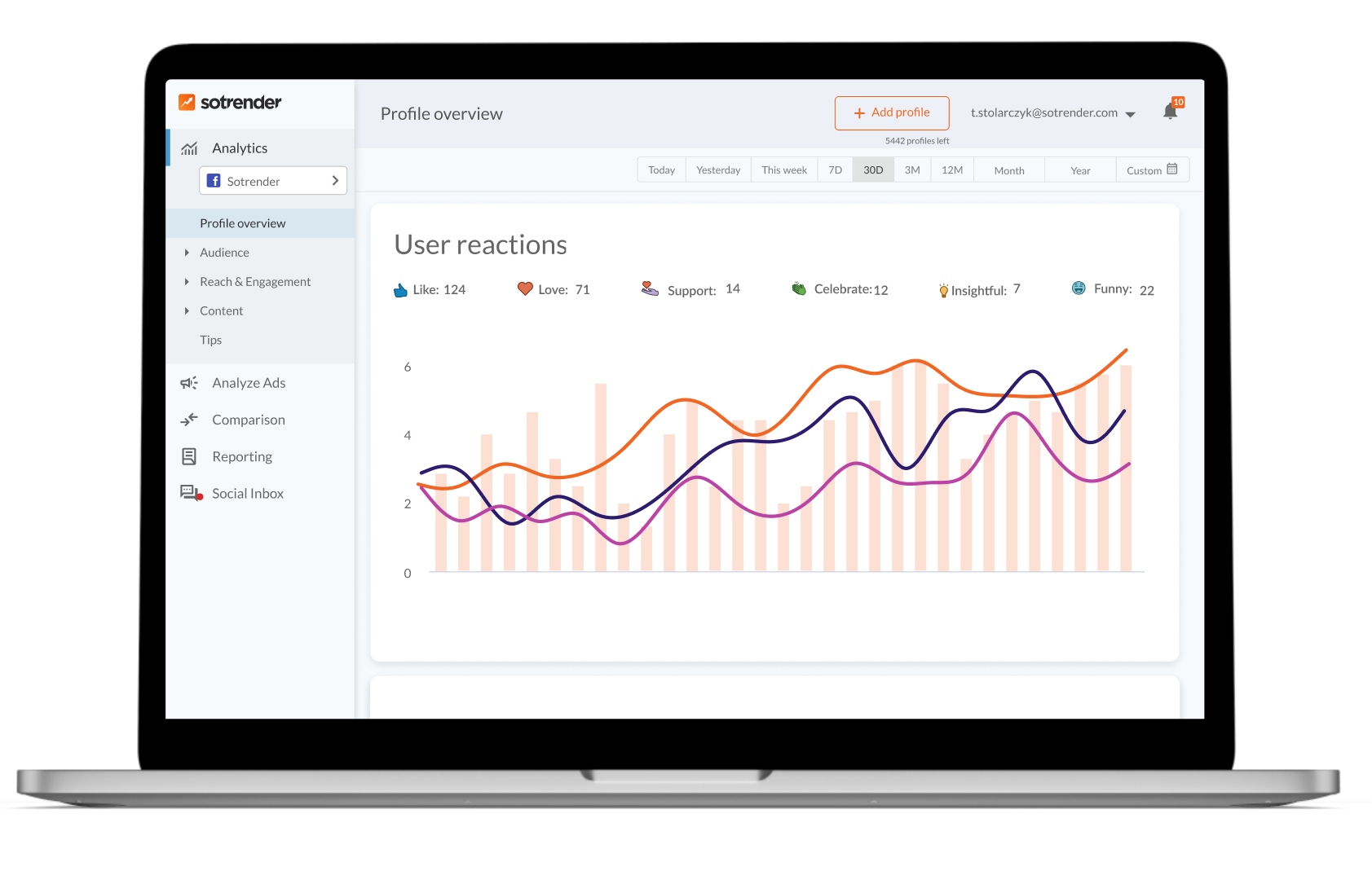With Facebook ads now being an inevitable part of all social media marketing activities, marketers are struggling to increase their effectiveness.
But how do you achieve better ad results and reach more people without increasing the given budget? How do you reduce CPM on Facebook ads?
Keep reading to find 6 proven methods.
Sneak peek: Hop to the second-to-last section to see how the latest AI solutions can help you reduce CPM on Facebook Ads much faster.
What is Facebook CPM and how is it calculated?
Let’s first make it crystal clear what CPM is.
In digital marketing and specifically the advertising industry, CPM is an acronym for cost-per-mille (sometimes also called cost-per-thousand), which tells us how much you paid to display an ad a thousand times on, for example, Facebook or Instagram.
CPM is calculated based on this formula:
total ad spend divided by the number of impressions, multiplied by 1000.
You don’t usually have to calculate it on your own, as many tools, including Facebook Ads Manager, will automatically calculate it for you. However, as a marketer, you should know how it’s measured – this knowledge will enable you to take the necessary steps toward lowering this cost.
What is the most optimal scenario of achieving a reduced CPM on Facebook? Usually getting more impressions (or having more people see your content) without increasing the budget.
Where can I find the CPM metric?
You’ll find your CPM data in Facebook Ads Manager as well as in social media analytics tools, but only those that have paid analytics.
Here’s how it looks in Facebook Ads Manager.

And here is how it may look in a third-party analytics tool – in this case, in Sotrender.


Of course, in every external social media tool the CPM value will be presented in a slightly different way.
How to reduce CPM on Facebook Ads in 5 different ways
Let’s get practical.
There are many activities you can do to lower your CPM. Some of the most frequently used (and usually the most effective) methods are, in our opinion, the ones described below.
1. Broaden your target audience
By expanding your target audience, e.g., by adding additional interests or locations, you make it easier for Facebook to reach people relevant to you. The narrower your set audience is, the harder it will be for the algorithm to find users that match your criteria. That’s why your ads become pricier, as Facebook has to put more effort into finding relevant people.
2. Make your ads more attractive and catchier
If your creatives are dull and aren’t attention-grabbing, people will scroll through their feed without even noticing them. Make sure your ads are visually appealing, vivid, interactive – do whatever it takes to make people stop and focus on your message.
Check Facebook best practices for creating visuals that convert >>>
3. Take time to understand your industry specification
Each industry is different and you have to know when it’s the low and high season, as that’ll greatly affect your ad costs. One of the strategies of lowering CPM on Facebook Ads is by intensifying your campaigns when you don’t have to compete with many advertisers. If a lot of brands are fighting for a specific audience’s attention, the ad costs will be much higher. Once you know in advance when your competitors will be most active, you can outsmart them and start your campaigns, for example, a few weeks before.
4. Test various audiences
We hope that you have a pretty clear definition of your ideal target audience for each campaign, as it’s crucial for reaching them effectively and precisely. However, there are probably dozens of ways of reaching them. That’s why it’s always good to try and test various target audience settings, especially interests, but also life events or job titles. People have various hobbies and there can be so many different combinations of their interests and other characteristics.
5. Play with ad frequency
One important metric in brand awareness and reach campaigns is ad frequency. Facebook lets you set how many times each ad will be displayed to one user. Usually, it’s advised to set 2-3 impressions per 7 days. However, you can significantly affect your CPM by lowering or increasing ad frequency, depending on your audience and goal.
These are only a few methods of lowering the CPM of your Facebook Ads.
Generally, to optimize your Facebook ads, or reduce the CPM or CPC values, you have to test various ad settings, target audiences, placements, and visuals. There is no secret formula that will work for each and every brand and guarantee a lower ad cost.
But is there a way to quicken this process?
How to automate the process of reducing CPM on Facebook Ads
Implementing all the methods mentioned above can lead to great results. However, these kinds of tests are time- and budget-consuming.
Testing the above methods and getting tangible results can take weeks or even months. Marketers don’t have that much time – or budget 
With AI, marketers can now increase both their work efficiency and the effectiveness of their paid and organic campaigns.
That obviously includes Facebook Ads.
And that’s where Sotrender’s AI Ads Optimization comes in.
Our Ads Optimization is an AI-driven solution that provides marketers with automatic recommendations for better ad settings.
It basically indicates which of the campaign settings you’ve previously chosen should be changed to achieve an even better result, understood as a lower CPM (or CPC) or an increased number of impressions. And all of this achieved with an unchanged budget.
To better understand how Ads Optimization works, take a look at the following example.

After choosing which ad you want to optimize, first, at the top of the screen, you’ll see the expected improvement after implementing all the recommendations provided by our model.
Then you’ll see a list of all recommendations generated for your ad.
On the left you’ll see the current ad settings, and on the right both new recommendations and information about the impact each change will have on your ad performance.
You’ll get new setting recommendations in the following dimensions:
- Age
- Targeting (such as interests, job titles, life events, etc.)
- Device
- Platform
- Placement
Important
You’ll achieve the expected improvement (in this case, 20.6%) only by applying all the recommendations suggested by our model. You can implement only select recommendations, but that will impact the overall improvement.
Why is it better to use Ads Optimization rather than doing all this manually?
Our optimization works based on artificial intelligence algorithms trained on hundreds of thousands of ads from the Meta ecosystem. Thanks to that, they’re able to detect patterns in campaign settings that significantly affect their quality and final results.
Let’s sum up all the benefits of using Ads Optimization.
- Increased efficiency. You’ll achieve better ad results within the same budget.
- Ready-to-use solutions. You’ll save time by accessing ready, automatically generated suggestions on optimal ad settings.
- Full control. You’ll have complete control over implementing recommendations proposed by our model.
- Acting in your best interest. Our algorithms work only to your advantage.
- Competitive advantage. You’ll gain access to solutions and recommendations your competitors aren’t using yet, and you’ll get a chance to outperform them.
How to reveal the CPM of other advertisers
Some marketers, especially those less experienced, will struggle with understanding if their CPM results are actually high or low.
With Sotrender, they can discover that, too.
By using the Benchmarking tab, you’ll immediately see how your ad results stack up against competitors’ results.
You can analyze metrics such as:
- The number of impressions
- The number of clicks
- CPM (cost-per-mille)
- CPC (cost-per-click)
You’ll see if, compared to similar advertisers, your results were good or if there’s room for improvement in terms of, for example, lowering your CPM or CPC.

By using Sotrender’s Benchmarking, you’ll immediately know if there’s something you should work on or whether you can be happy with your results and focus on other aspects of your social media presence.
See how you can analyze all aspects of competitor Facebook ads >>>
Learn how to reduce CPM on Facebook Ads with the help of AI
Optimizing Facebook ads is definitely not a cake walk. It’s actually a tedious and time-consuming process. For marketers who don’t necessarily specialize in social media ads, figuring out optimal ad settings can end up a daunting task.
To make their lives easier, software companies, including Sotrender, developed various AI solutions that simplify and automate many complex tasks, including optimizing Facebook ad campaigns.
By using Sotrender’s Ads Optimization, you’ll be able to achieve better ad results without the need to increase your ad budget and justify higher expenses.
Now you can finally learn how to reduce CPM on Facebook Ads and how to keep both the process and the results satisfying.




